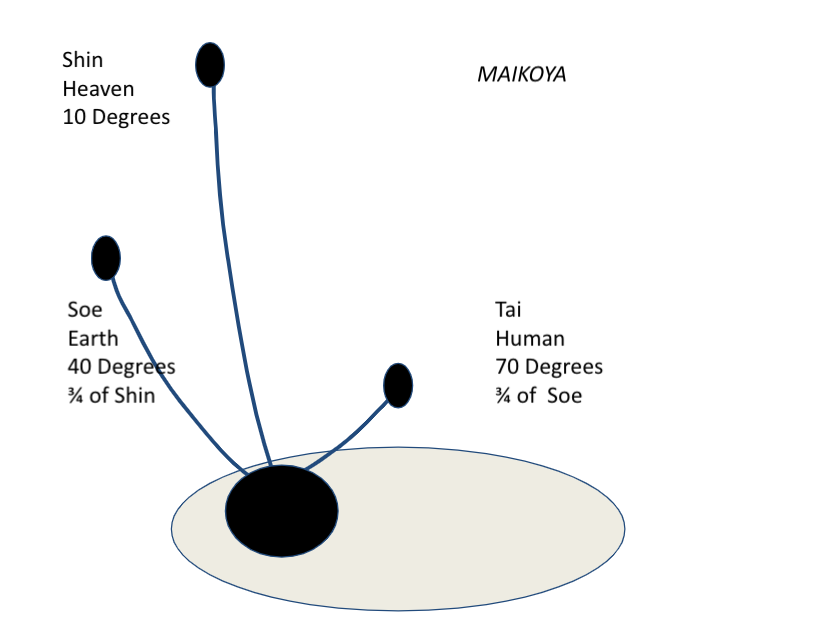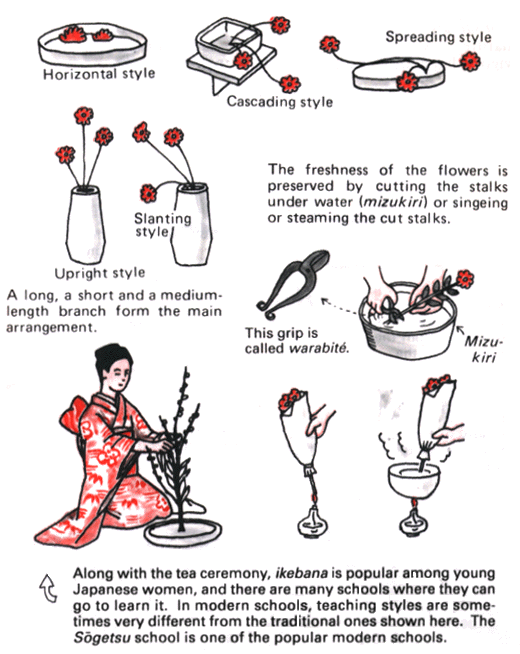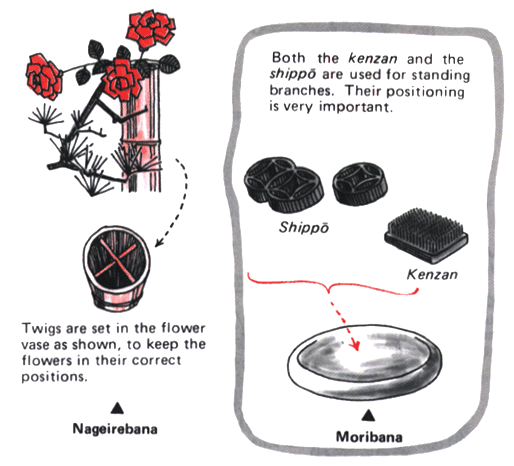Japanese Art of Flower Arrangement Based on Symbolic Use of Flowers
Definition
Ikebana is the art of blossom arranging that originates in aboriginal Japan. Information technology is skillful equally an art where flowers and other natural elements are placed in such a way as to embody harmony, peace, and beauty. Ikebana, also known as kado in Japanese, is considered to be the top 3 major forms of cultural arts along with Tea ceremony and calligraphy.
During the Heian period, the priests who took care of altar arrangements were chosenikebono and they are the showtime known masters who developed the best fashion of arranging flowers. Ikebana has unproblematic rules influenced by simplicity and minimalism in Buddhism. There are usually3 types of main flowers: primary flower in the heart, the secondary flower correct next to it and an ornamental bloom down below. There are also two main types of vases: thebroad and low vase chosen moribana and the tall thin vase called nageire.
Ikebana, Japanese Culture and Zen Philosophy
Ikebana was born in Buddhist temples and has a close relationship to the philosophy of Zen. The ten connections between zen and ikebana are explained beneath
- Zen is about harmony, residual and minimalism , ikebana is also nearly harmony, balance and minimalism
- Zen is well-nigh being natural and preserving the nature of things , ikebana makes the flowers how they await in nature; dissimilar from the popular blossom bouquets in the Due west. Zen is also about being continued with nature as nosotros develop a sense of closeness to flowers thus mother nature.
- Zen is about mindfulness , and realizing the passing of times. Zen is understanding and enjoying the transience of life. ikebana uses seasonal flowers to aid us appreciate the changes of times and seasons.
- Zen is about seeing beauty in a routine, ikebana helps us create fine art forms from simple flowers.
- Zen helps us capeesh ma (the beauty of empty infinite and emptiness) and ikebana helps us realize and enjoy ma or the unfilled spaces in a bowl.
- Zen is about no discrimination , with the assist of ikebana anyone, regardless of any social class, can create art with whatsoever flowers.
- Zen is about selfless mind, ikebana helps us forget the flow of time while arranging the flowers.
- Zen is about getting rid of negative and materialistic thoughts, the earth of flowers moves us abroad from harmful thoughts
- Zen and shinto are about being close to the divine spirit , the flowers have symbolic meanings related to the earth and heavens
- Zen is about a peaceful and svelte mind , the art grade nosotros create represents our true nature which is naturally peaceful.
Simple Rules of Ikebana

Ikebana Principles
The most simple rule of ikebana is the dominion of three also known as the most basic moribana manner.
-
- In the middle there is the longest stalk, shin. This stalk represents heaven. The stem is 1.v taller than any other flowers or branches. The stem is set leaning ten degrees left side from the base of operations.
- Left side of the shin at that place is soe which represents globe. This part is tilted xl degrees to the left side of the base and has the three quarters length of the longest stem.
- On the correct side at that place is the shortest stem called tai . This stem is tilted 70 degrees to the right side and has the length 3 quarters of the second longest stem.
Japanese Symbolism in Ikebana
Ikebana has many rules and principles similar to other civilisation based crafts influenced by the zen philosophy. Showtime timers are surprised to discover out that each bloom also has a significant in Japan such as pines correspond longevity, chrysanthemums represent the imperial family unit, lotus flowers imply purity of mind and torso and many seasonal flowers similar peonies and wisteria stand for grace and dazzler. Some people likewise think the centre branch in ikebana refers to Buddha but this depends on the amalgamation of the practitioner.
Ikebana Vocabulary
Iki: A Japanese aesthetic chemical element that translates to 'refined uniqueness'.
Moribana: A pop mode of flower arrangement that translates to 'piled up'. The flowers and other elements are placed in depression, shallow containers.
Nageire: Another popular style of blossom organization that translates to 'thrown in'. The natural items are organized in alpine vases.
Rikka: A traditional style of flower arrangements that translates to 'continuing flowers'. This style uses seven branches to correspond natural scenes.
Shoka: A blazon of flower organisation that embodies the spiritual world.
Shin: A co-operative that represents heaven and is an of import chemical element in shoka flower arrangements.
Soe: A co-operative that represents man and is an important element in shoka flower arrangements.
Tai: A branch that represents globe and is an of import chemical element in shoka blossom arrangements.

Ikebana Nihon, JNTO

Ikebana Nippon, JNTO
Ikebana Elements
Ikebana is vastly unlike from other types of flower arrangements in Western countries. Flower arrangement in the West consists of arranging flowers and other plant elements symmetrically in a vessel. Ikebana is fundamentally different due to its higher pursuit to develop a closeness with nature during the creation process. Hither are the design elements Ikebana takes into consideration:
• Minimalism: Buddhist ethics of minimalism are at the core of ikebana. The natural elements put into the arrangements are like sculptures and should each take a purpose. For example, leaves should be chosen past how they complement i another and with the style of the finished display as a whole.
• Shape and Line: This chemical element also has ties to Buddhism as all shapes and lines should be placed in a natural-looking position. For instance, upright arrangements oftentimes made with branches that offer stiff, straight lines. This embodies a tree's strength and rigidity. A slanting way of arrangement is fabricated with softer elements by incorporating flowers and grasses that grow slanting downward. This also gives a sense of movement and grace.
• Structure: Many traditional Japanese flower arrangements are based on a scalene triangle. The points of the triangle are normally fabricated with twigs or branches. A popular style called shoka takes this one step further, as this style's arrangements represent the spiritual globe with its use of structure. The longest branch or flower in the system is called shin, and this represents heaven. The medium branch or flowers, soe, represents human being, and the shortest co-operative or flowers, tai, represents earth.
• Course: The final design of the flowers and other plant elements should be 'constitute' during the arrangement, rather than being planned and forced. It is said that you lot should notice what is 'already there' in the flowers, branches, and leaves you accept chosen. A typical ikebana system emphasizes asymmetry and imperfection through the use of gratis space, uneven numbers, and a minimal number of blooms.
• Aesthetics: The overall feel of the arrangement should embody traditional Japanese values. A way to draw it is iki or 'refined uniqueness'. A style that explains this is rikka or the 'standing flowers' style. This fashion uses seven branches to make or represent the beauty of natural landscapes such as hills, waterfalls, and valleys in their arrangements.
• Humanity and silence: Ikebana is said to also be an embodiment of the arrangement'south creator. Information technology reflects the creator's mood and personal journeying with nature. A style I think embodies this is one with a moribana system which utilizes the shallow bowl information technology is arranged in as a reflective pool. Finally, while taking part in ikebana you shouldn't speak. This process should exist a meditative activity where you are only focused on the natural elements taking shape in front of you.
Fun Facts nigh Ikebana
- Just like Karate the ikebana schools also have the "dan" or the ranking system. Even though yous don't get a black belt, you can go a loftier ranking "kyu" if yous exercise ikebana for a very long fourth dimension.
- There are thousands of ikebana schools in Japan alone, with the almost well known beingness the Ikenobo Schoolhouse, which started in the Choho-ji temple in Kyoto. It has since spread chapters all over the world and recently has grown to incorporate over 60,000 teachers in many dissimilar countries. Ikebana is still very popular in its home country as it is skilful by roughly 15 1000000 people annually, many of whom are young women.
- While many women practice ikebana, it is likewise a cultural activity that was historically good by men as well. In fact, samurai warriors would demand to be taught bloom arranging, likewise as other important cultural activities, before existence recognized as a true warrior. Currently, there are more leading male Ikebana masters than females.
- Mod styles and techniques are irresolute how ikebana arrangements are put together. One such chief who has embraced new styles is Techigahara Sofu who used plaster, plastic, and even steel in his blossom arrangements. He founded the Sogetsu School and so his ideals of experimentation are practiced by new students also.
- In improver to the Ikenobo School, two other well-known schools are the Sogetsu Schoolhouse and the Ohara School. These two schools are more mod, each beingness around for roughly a century. The Sogetsu School and Ohara School were founded by ikebana masters who wanted to incorporate more popular Western elements.
- If you do attend an ikebana arrangement class, some of the classes you would need to have are using scissors to trim different plants correctly, bending branches then they don't pause or look unnatural, selecting flowers to symbolize traditional elements, identifying the appropriate vase or bowl for your arrangement and learning how to keep your natural elements as fresh equally possible.
- There are ikebana organisation displays where you can see experts showcase their abilities and techniques. Many of these exhibitions are about 'friendship through flowers' rather than competition and are known in Japan as well as other countries. There are also annual arranging competitions in Nihon where masters compete. In these competitions, the masters have the same equipment, flowers, and plants just should use their personal taste and experience in making dissimilar arrangements.
- Ikebana is available for students through later school classes and clubs for those wanting to learn. Ikebana is also regularly shown through 'how-to' videos and on Japanese Boob tube shows. One such prove is Seikei Bijin or Artificial Dazzler, a drama TV serial which has an ikebana master as a male character and love interest.
- While not ikebana, a related cultural action from Japan is called kodo. This is the traditional art of fragrance and using incense. This practice is generally learned if a Japanese woman wishes to be considered to be refined, alongside ikebana and the traditional Tea ceremony. This has another tie to ikebana equally some of the flowers used in the arrangements are besides popular incense scents.
- Another Japanese cultural activity that has ties to flowers is bonsai growing. This is the art of growing small trees in particular shapes in order to showcase their beauty and natural grace. Many aesthetics found in the ikebana bloom arrangements are as well of import in bonsai growing.
- A practiced online resource if you wish to keep on your ain ikebana journey is found at. This website has a step past step tutorial to assistance with the skills and techniques you need to brand your own bloom arrangement. Because there are as well ikebana teachers effectually the earth, you may observe a qualified instructor near you if you search online.
History of Heika Mode Ikebana
The word Ikebana itself ways 'live arranged flowers' or 'giving life to flowers' in English. This cultural activity has origins in Buddhist temples as flowers were used for offerings as far back as the seventh century. Adding leaves and other natural elements into flower arrangements is referenced equally an idea from another Japanese organized religion, Shinto. Shintoism believed all-natural elements as beautiful and spiritual, not just flowers. Ikebana became an art manner in its ain right during the fifteenth century every bit Buddhist monks began pedagogy others the rules of their bloom arranging in society for others to create arrangements themselves.
Every bit a result, Ikebana schools were formed, each having their own distinctive flair and style. The flower arrangements became a symbol of fine art in the homes of the aloof. It was during this time that styles similar the nageire were associated with other exclusive cultural pursuits like the tea ceremony and haiku poetry. In mod times, other arts and blueprint styles and techniques have influenced ikebana, but the fundamental principals have remained the aforementioned. The about important of these is that ikebana is yet seen as a spiritual pursuit in helping merge the indoors and outdoors.
Get-go by looking atikebanahq.org.Finally, in that location are many Youtube videos and web pages to aid y'all if you desire to exercise this art at home.
Page updated:
Source: https://mai-ko.com/travel/culture-in-japan/floral-art/japanese-ikebana-or-flower-arranging/
0 Response to "Japanese Art of Flower Arrangement Based on Symbolic Use of Flowers"
ارسال یک نظر